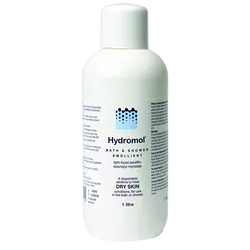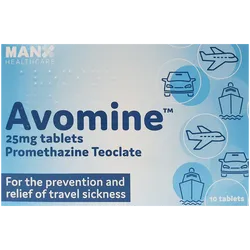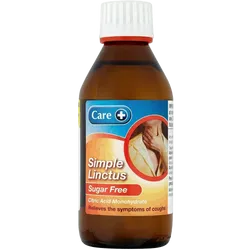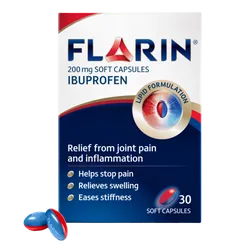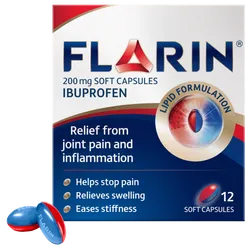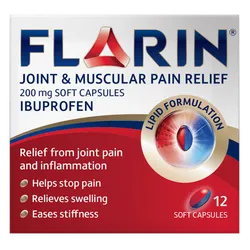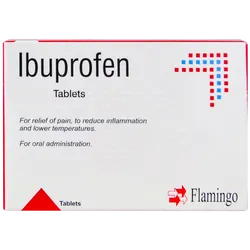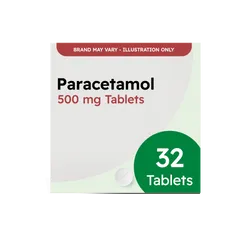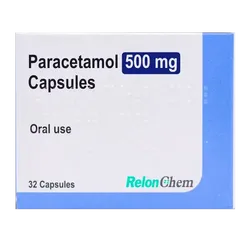-
Hydromol Emollient Bath Additive 1ltr £15.15 save £1.86
-
Avomine Tablets 25mg Pack of 10 £2.39 save £0.67
-
Care Simple Linctus Sugar-Free 200ml £2.15 save £0.54
Aches and pains are extremely common. Anything from headaches to muscle pain can cause significant discomfort. This may be why some of the most popular medicines are pain relief tablets.
When it comes to pain relief, there are a wide array of products to choose from. It is important to understand the differences and purposes of each product before use to ensure you choose the right product for your needs. Our guide explains what three popular pain relief products are and their purpose: Flarin, Ibuprofen and Paracetamol.
What is Flarin?
Flarin is an innovative brand that offers products for joint pain and inflammation relief.
Do I need a prescription for Flarin?
Flarin products can be purchased in pharmacies and some supermarkets without a prescription. They can also be ordered from online pharmacies that have been approved to sell medicines online. Find out how you can check if a website is selling medicines online safely and legally with our guide.
Flarin Ibuprofen Capsules
Flarin Ibuprofen capsules contain ibuprofen and have been created to help soothe and relieve a range of different types of pain. These include:
- Joint pain
- Pain of non-serious arthritic conditions (caused by swelling and stiffness)
- Rheumatic pain
- Muscle pain
- Back pain
- Neuralgia (a sharp pain along nerves)
- Migraine
- Headache
- Dental pain
- Fever
- Cold and flu symptoms
Flarin's formula is created from a complex manufacturing procedure whereby lipids, ibuprofen and other excipients are heated together in order to create effective pain relief.
Lipids help with absorption and usually pass from the stomach into the small intestine where they are then absorbed into the lymphatic system. Lipids are fatty substances such as oils, butter and fat. They are used in Flarin's forumla to help aid absorption.
How to use Flarin Capsules
- Always read the leaflet and box for every product before use.
- Adults, the elderly and children aged 12 years and older can take 1 or 2 capsules with water. If required, then take 1 or 2 capsules up to 3 times daily. Leave at least 4 hours between doses.
- Do not exceed 1200mg (6 capsules) in any 24 hour period.
- Flarin capsules are not suitable for children under 12 years. The product should be kept out of sight and reach of children at all times.
What is Ibuprofen?
Ibuprofen is an everyday painkiller that is used in the treatment of aches and pains, including back pain, period pain, and toothache. It can also be effective in treating inflammation and pain from arthritis making it an on-demand medicine.
It can be purchased in the form of tablets, capsules, and syrup. There are also pain relief products available that combine ibuprofen with other ingredients. It can be found as a gel, mousse or spray that is rubbed onto the skin where the pain is located.
Do I need a prescription for Ibuprofen?
Ibuprofen can be purchased over the counter at pharmacies and supermarkets with only specific types of the medicine needing a prescription. However, there are restrictions in relation to who should use ibuprofen therefore you must always read the box and leaflets before taking the product. The NHS have outlined information about ibuprofen for under 17 year olds and children.
How long does Ibuprofen take to work?
When you take ibuprofen by mouth in tablet, capsule or syrup form, it can take 20 to 30 minutes for it to take effect. If you take it by placing a gel or product onto the skin, it can take considerably longer to have an effect (1 to 2 days).
How Ibuprofen works
Ibuprofen works by reducing the hormones, prostaglandins, that cause pain and swelling in the body. The production of prostaglandins in the body is usually a response to illness and injuries. It is this hormone that causes pain, swelling and inflammation. This is why these symptoms are common when someone is not well.
- Using Ibuprofen for strains and sprains - It is recommended by some medical professionals to wait 48 hours before taking ibuprofen as it may slow down healing. Speak to a pharmacist for advice on how you should take the medicine to help in relieving symptoms.
- Ibuprofen tablets and capsules should be taken with food or a drink of milk to help in preventing an upset stomach. It should not be taken on an empty stomach.
What is Paracetamol?
Paracetamol is a common painkiller medicine used to treat aches, pains, and high temperature. It can be purchased in various forms including in products which combine the painkiller with other painkillers and anti-sickness medicines. Paracetamol is an ingredient also found in cold and flu products. There is a difference between paracetamol for adults and children under the age of 16 years old.
Paracetamol for Adults
Paracetamol is a great remedy for adults with aches and pains. They come in various forms including tablets, capsules, syrup and soluble tablets. It can take up to an hour to become effective and the recommended dose is one or two 500mg tablets at a time. It should not be taken along with other products which also contain paracetamol as this will also cause your dosage to be too high.
If you have ever had an allergic reaction to paracetamol or similar products, then you should not take this medicine and consult a doctor. You should also check with your doctor or pharmacist before taking paracetamol if you have liver or kidney problems,take medicine for epilepsy, tuberculosis (TB) or take warfarin (a blood-thinner).
When taking paracetamol, you should not drink more than the maximum recommended amount of alcohol (14 units a week). This is because alcohol and paracetamol affect the liver and using them together (when drinking more alcohol than recommended) can be damaging to the liver.
How to take Paracetamol?
- Take paracetamol with or without food.
- The dose for adults is one or two 500mg tablets up to 4 times in 24 hours. Always leave a minimum of 4 hours between doses. Do not exceed 8 tablets with a 24 hour period.
- Overdosing on paracetamol can cause serious side effects. Do not increase the dose or to take a double dose if your pain is very bad, instead consult with a medical professional.
- If you take more than 8 tablets within 24 hours, or take more than 2 extra tablets of paracetamol then you must go to the nearest A&E (accident and emergency services).
Paracetamol for Children
Paracetamol is also used often for children to treat headaches, stomach ache, earache, and cold symptoms. It is also sometimes used to bring down a high temperature.
For children, it depends on their age (and occasionally weight) what type of paracetamol they can take along with the dosage they can take. There are precautions that must be taken. Always read the leaflet and box before giving children paracetamol and any other medicines.
- It can take up to 30 minutes after taking a tablet or syrup for the effect to be felt.
- Do not give your child any other medicines that contain paracetamol. These include certain cough and cold medicines. Check every product's leaflet and ingredients carefully to ensure they do not contain paracetamol.
- Paracetamol is dangerous if your child takes too much. Keep it out of reach from children and always take your child to the nearest A&E (accident and emergencies service) if your child has taken too much.
How to give paracetamol to children
Firstly, do not give paracetamol to babies younger than 2 months old unless it is prescribed by a doctor. If you believe your young baby may be unwell, take them to a medical professional immediately.
You should check with a doctor or pharmacist before giving your child paracetamol if they:
- are small for their age because (this may mean that they need to take a lower dose which the medical professional should determine)
- have had liver or kidney problems
- take medicine for epilepsy, tuberculosis (TB), or take warfarin (a blood-thinner)
You can give paracetamol to children as:
- Liquid syrup – from the age of 2 months
- Suppositories – from the age of 2 months
- Tablets – from the age of 6 years
- Calpol Fast Melts – from the age of 6 years
Calpol for children
Calpol is a popular brand for parents as they offer a range of products tailored for pain relief in babies and infants. You must check the product before giving it to a child because each product has different ingredients and instructions meaning they are not suitable for children of every age. With flavoured and sugar free products, they are a great choice for many parents. Below are some of their most popular products which you can explore to see which is right for you and your child (always read the box and leaflet before use).
Calpol Six Plus Sugar & Colour-Free Suspension (Strawberry)
Calpol Six Plus Sugar & Colour-free Suspension is used in the treatment of mild to moderate pain and feverishness. It is suitable for children 6 years of age and older, and is also an option for adults who prefer it. It’s active ingredient per 5ml is Paracetamol 250mg and has been formulated using other ingredients in combination with paracetamol to make an effective pain relief syrup.
Directions of Use:
- Children aged 6 - 8 years: Up to 4 times a day: 5 ml.
- Children aged 8 - 10 years: Up to 4 times a day: 7.5 ml (5 ml + 2.5 ml).
- Children aged 10 - 12 years: Up to 4 times a day: 10 ml (5 ml + 5 ml).
- Children aged 12 - 16 years: Up to 4 times a day: 10-15 ml (Two to three 5 ml doses).
- Adults and children over 16 years: Up to 4 times a day: 10-20 ml (Two to four 5 ml doses).
- Not recommended for children under 6 years old.
Warnings:
This medicine is not recommended for children under the age of 6 years old. This medicine is not suitable for everyone and every child. You must read the product warnings, box, and leaflet before use. If you are unsure this is the right product to use, then always ask your doctor before using the product.
Calpol Infant Suspension Strawberry Flavour Sachets
Calpol Infant Suspension Strawberry Flavour Sachets is a strawberry flavoured oral suspension that can be used to help your child relieve pain and fever which could be caused due to:
- teething
- headache
- toothache
- sore throat
- post-immunisation fever
- cold and flu
- earache
- other aches and pains
The product contains Paracetamol 120 mg per 5 ml and has been combined with other ingredients to create an effective formula.
Directions of Use:
The product is intended for oral use only and each sachet contains 5 ml of this medicine. The product also comes with a double-ended spoon.
- Babies 2-3 months, weight 4kg+, was not born before 37 weeks - one small 2.5ml spoonful (half a sachet)
- If necessary, after 4-6 hours, give a second small 2.5ml spoonful (half a sachet).
- Do not give more than 2 doses.
- Leave at least 4 hours between doses.
- Babies 3-12 months - one to two small 2.5ml spoonfuls (half a sachet), up to 4 times a day.
- Children 1-6 years - one to two large 5ml spoonfuls (sachet), up to 4 times a day.
- Do not give more than 4 doses each day.
- Leave at least 4 hours between doses.
- Do not give your child this medicine for more than 3 days without speaking to your doctor.
If further doses are needed, speak to your doctor. Never use more medicine than recommended on the product’s leaflet, table or on the box. Do not overfill the spoon as you could give too much medicine if you do.
Warnings:
This medicine is not suitable for everyone and every child. You must read the product warnings, box, and leaflet before use. If you are unsure this is the right product to use, then always ask your doctor before using the product.
Paracetamol Brands
There are leading and popular brands which offer paracetamol products. These include Calpol, Hedex, and Panadol. Discover affordable pain relief products and find one which will suit your needs with our online pharmacy today.

